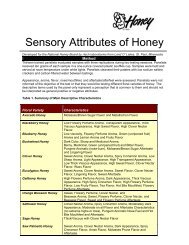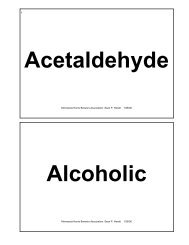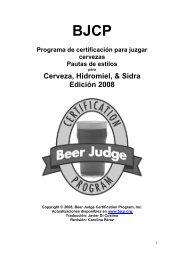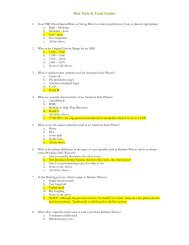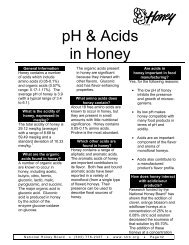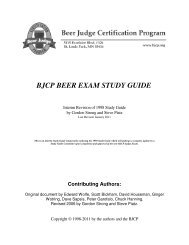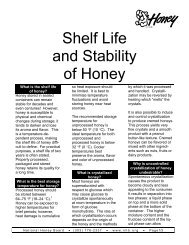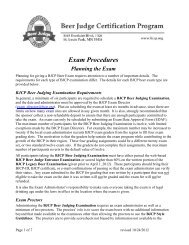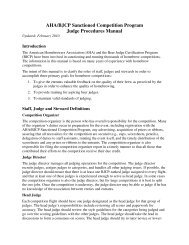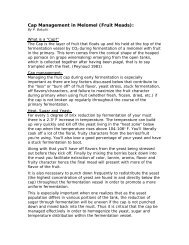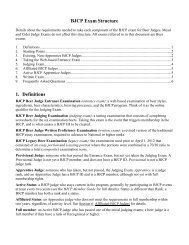Making Mead - BJCP
Making Mead - BJCP
Making Mead - BJCP
You also want an ePaper? Increase the reach of your titles
YUMPU automatically turns print PDFs into web optimized ePapers that Google loves.
Table 2. Basic Steps For<strong>Making</strong> <strong>Mead</strong>1. Clean and sanitize allequipment andcontainers.2. Make the must (i.e.,honey-water mixture).3. Add the yeast or yeaststarter.4. Ferment until all visualsigns of air bubblesdisappear.5. Rack (fine first, ifdesired) two or moretimes.6. Age until clear andgood flavor develops.7. Bottle and cap with bottlecaps or corks.FERMENTATIONFermentation takes fromseveral weeks to severalmonths. During this step,the sugar in honey isconverted to alcohol andcarbon dioxide gas.Once the must has beensterilized (by boiling,pasteurization or sulfitetreatment), transfer it to thefermentation vessel(carboy) and add theactivated yeast.At the onset of fermentation,yeast need an amplesupple of dissolvedoxygen. Therefore, it ishelpful to cascade the coldmust into the carboy priorto adding the yeast. Air isexcluded during theremainder of thefermentation process byinstalling an air lock on theneck of the carboy.RACKINGRacking involves siphoningoff the clear mead into asecond sanitizedfermenter, leaving thesediment behind in thefirst. This step is repeatedas many times as isnecessary to achieve thedesired level of clarity,usually at three-monthintervals.Strict sanitation practicesmust be observed to preventcontamination. (Ifsulfiting agents are used asa disinfectant, they need tobe added at each rackingto ensure the desired levelof 50 ppm sulfur dioxide.)Care must also be taken tonot incorporate oxygenduring racking after theonset of fermentation.Excess exposure tooxygen once the processhas begun, can causespoilage. When filling thecarboy, headspace shouldbe limited to approximatelyone inch to minimize theavailable oxygen.FININGFining is an optional stepthat clarifies mead, usingagents such as bentonite,isinglass, egg white,gelatin, and casein. Acommercial product calledSparkolloid is alsoavailable. Fining agentscombine with chargedparticles in suspension,such as protein, andprecipitate them. The resultis clear mead that has asparkle. The drawbacks tofining are the amount ofmead left in the residueand the potential fordecolorizing the mead.Fining is usually donebefore racking or whenmead fails to clear. Afterracking, attach the air lock.Fermentation will begin inseveral hours or may takeseveral days. <strong>Mead</strong> is bestfermented at temperaturesbetween 70 °F and 80 °F.Fermenting at lowertemperatures will not harmthe mead flavor; it will justtake longer to complete.During fermentation, rackthe mead into a newcontainer as sedimentdevelops. If the mead sitson the sediment too long,the yeast will begin to feedon the sediment (autolysis)and result in an unpleasantflavor. Fermentation iscomplete when air bubblesare no longer visible.AGINGAging requires the mostpatience. During this step,the mead clears anddevelops its flavor. Usually,it moves from a harsh,acidic, unpleasant taste toa smooth, mellowbeverage with a nicebouquet and fragrance. Asthe dead yeast cellscontinue to settle, it isimportant to continueracking the mead. A steadytemperature below 70 °F(preferably around60 °F) is recommendedthrough the aging process.The length of aging cantake months or years,National Honey Board • (303) 776-2337 • www.nhb.org • P a g e 6/12



